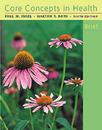Paul M. Insel,
Stanford University, School of Medicine
Walton T. Roth,
Stanford University, School of Medicine
| proof value | Two times the percentage of alcohol by volume; a beverage that is 50% alcohol by volume is 100 proof.
|
 |
 |
 |
| alcohol | The intoxicating ingredient in fermented liquors; a colorless, pungent liquid.
|
 |
 |
 |
| metabolism | The chemical transformation of food and other substances in the body into energy and wastes.
|
 |
 |
 |
| blood alcohol concentration (BAC) | The amount of alcohol in the blood in terms of weight per unit volume; used as a measurement of intoxication.
|
 |
 |
 |
| *cirrhosis | A disease in which the liver is severely damaged by alcohol, other toxins, or infection.
|
 |
 |
 |
| cardiac myopathy | Weakening of the heart muscle through disease.
|
 |
 |
 |
| fetal alcohol syndrome (FAS) | A characteristic group of birth defects caused by excessive alcohol consumption by the mother, including facial deformities, heart defects, and physical and mental impairments.
|
 |
 |
 |
| alcohol abuse | The use of alcohol to a degree that causes physical damage, impairs functioning, or results in behavior harmful to others.
|
 |
 |
 |
| alcohol dependence | A pathological use of alcohol, or impairment in functioning due to alcohol; characterized by tolerance and withdrawal symptoms; alcoholism.
|
 |
 |
 |
| alcoholism | A chronic psychological disorder characterized by excessive and compulsive drinking.
|
 |
 |
 |
| binge drinking | Periodically drinking alcohol to the point of severe intoxication.
|
 |
 |
 |
| DTs (delirium tremens) | A state of confusion brought on by the reduction of alcohol intake in an alcohol-dependent person; other symptoms are sweating, trembling, anxiety, hallucinations, and seizures.
|
 |
 |
 |
| tobacco | The leaves of cultivated tobacco plants prepared for smoking, chewing, or use as snuff.
|
 |
 |
 |
| nicotine | A poisonous, addictive substance found in tobacco and responsible for many of the effects of tobacco.
|
 |
 |
 |
| cigarette tar | A brown sticky mass created when the chemical particles in tobacco smoke condense.
|
 |
 |
 |
| cerebral cortex | The outer layer of the brain, which controls complex behavior and mental activity.
|
 |
 |
 |
| coronary heart disease (CHD) | Cardiovascular disease caused by hardening of the arteries that supply oxygen to the heart muscle; also called coronary artery disease.
|
 |
 |
 |
| emphysema | A disease characterized by a loss of lung tissue elasticity and breakup of the air sacs, impairing the lungs' ability to obtain oxygen and remove carbon dioxide.
|
 |
 |
 |
| chronic bronchitis | Recurrent, persistent inflammation of the broncial tubes.
|
 |
 |
 |
| environmental tobacco smoke (ETS) | Smoke that enters the atmosphere from the burning end of a cigarette, cigar, or pipe, as well as smoke that is exhaled by smokers; also called secondhand smoke.
|
 |
 |
 |
| mainstream smoke | Smoke that is inhaled by a smoker and then exhaled into the atmosphere.
|
 |
 |
 |
| sidestream smoke | Smoke that comes from the burning end of a cigarette, cigar, or pipe.
|
 |
 |
 |
| alcohol related neurodevelopmental disorder (ARND) | Cognitive and behavioral problems seen in people whose mothers drank alcohol during pregnancy.
|



 2002 McGraw-Hill Higher Education
2002 McGraw-Hill Higher Education

 2002 McGraw-Hill Higher Education
2002 McGraw-Hill Higher Education